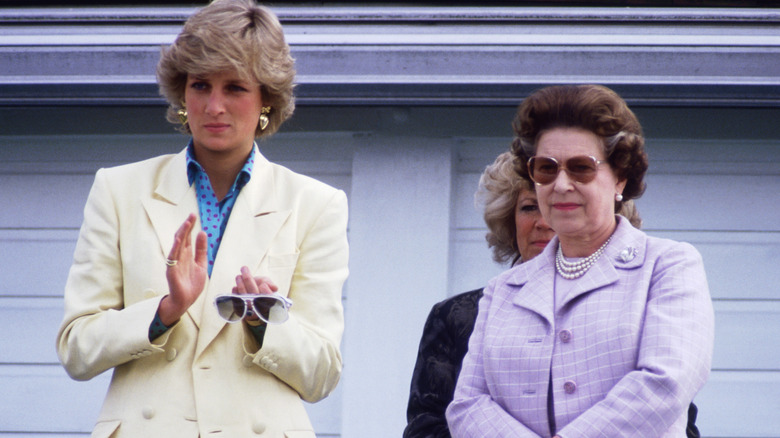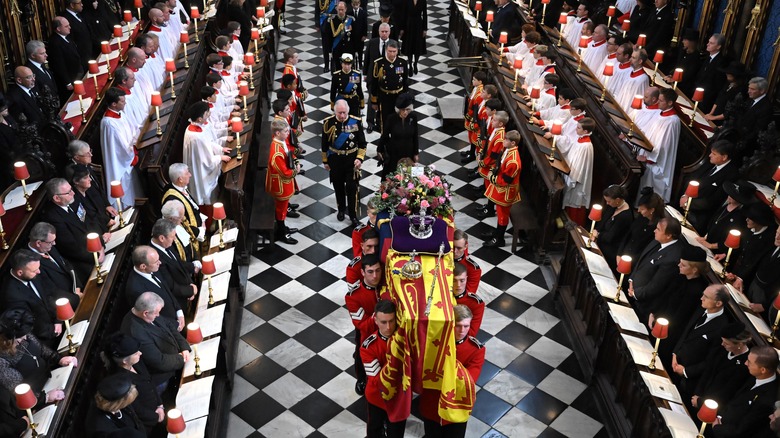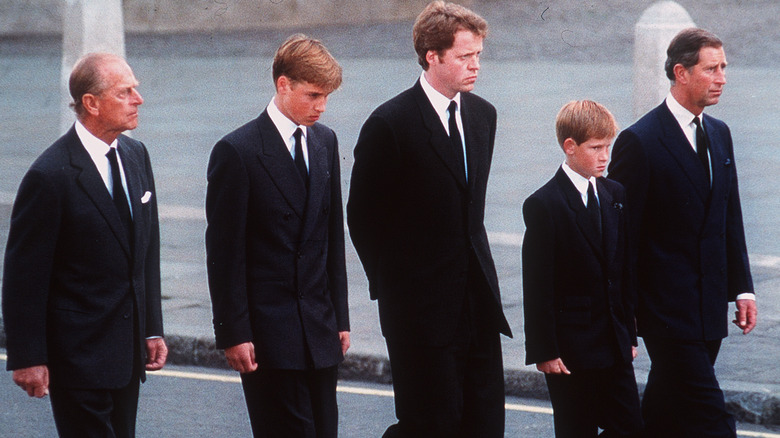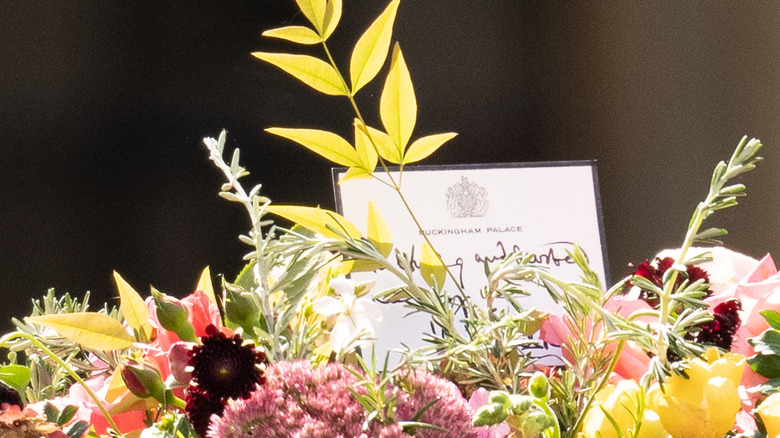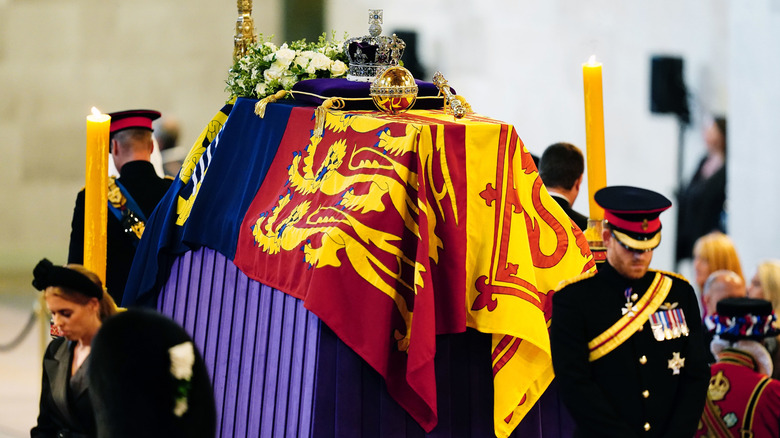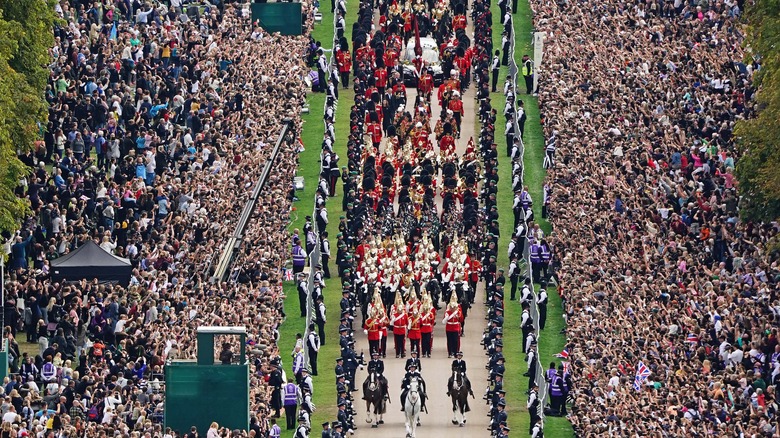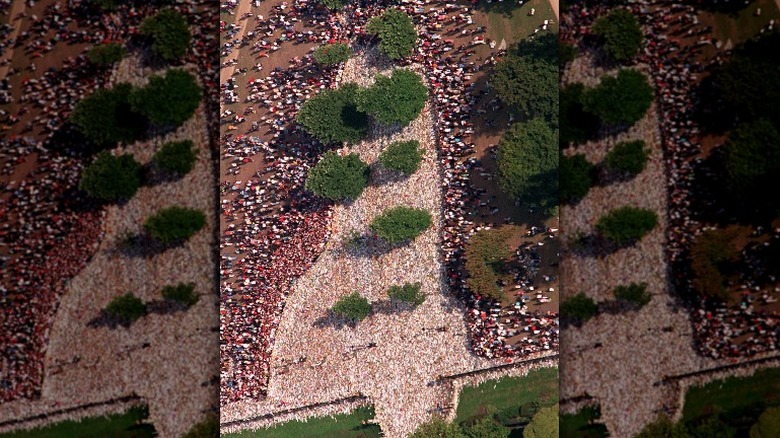How Queen Elizabeth's And Princess Diana's Funerals Were Eerily Similar
When Prince William and Prince Harry stepped out to meet mourners for Queen Elizabeth II in September 2022, they were naturally offered condolences for their grandmother. Some of those who spoke to William told the Metro that the prince was gracious to the public. Besides dealing with the loss of the moment, Jane Wells of Lincolnshire said that William told her the experience brought back memories of the death of his mother, Princess Diana. It was a feeling shared by many members of the public as well, reinforced by the sight of the brothers walking behind the queen's coffin as they had done for Diana's.
Technically, the queen and Diana's funerals were of different natures. As head of state for the United Kingdom, the queen was given a state funeral with the active involvement of the British government. It's a heavily regimented affair with longstanding traditions. Diana, though divorced from then-Prince Charles at the time of her death, was given a ceremonial funeral, a ceremony granted by the reigning monarch to other members of the royal family.
The distinction between the two ceremonies can seem minor, or a matter of scale or state presence rather than fine detail. But William and those in the public he spoke to didn't remember wrong. There were several parallels that bridge the 25-year gap between the funerals of Diana and Elizabeth.
Both funerals were held at Westminster Abbey
Something Princess Diana and Queen Elizabeth II shared with each other, and with members of the royal family going back centuries, is the site of their funerals. Both women had services held in Westminster Abbey, where several monarchs are buried going back to the time of Edward the Confessor. After being returned to the United Kingdom, Diana's coffin lay in the chapel of St James's Palace before her funeral on September 6, 1997, and the queen's lay in state in the Palace of Westminster (a.k.a. the Houses of Parliament) before her funeral on September 19, 2022. In having their services at Westminster Abbey, Diana and the queen in some ways harkened back to an earlier era; according to the abbey's own website, the normal site for state funerals, at least, is Windsor Castle, with George II being the last sovereign before Elizabeth to have his at Westminster.
Writing for The Telegraph, Charles Moore claimed to have sat in almost exactly the same spot in Westminster for both funerals. Both, he said, were regal displays of military ceremony and royal custom. But in his estimation, the key difference between the two was the atmosphere surrounding the funerals. Diana's death came when she was still young, and the public's grief at her loss, and anger at the royal family's perceived treatment of her. Elizabeth's funeral was the laying to rest of a long-serving and widely loved head of state, and the character of the service itself was more deeply religious.
The walk behind the coffin
One of the most noted moments of Princess Diana's funeral was the line of men walking behind her coffin. Prince Philip, Prince William, Diana's brother Charles Spencer, Prince Harry, and the then-Prince Charles followed the casket on foot as it was borne to Westminster Abbey for the funeral service. The decision to have two teenage boys take part in the walk has attracted criticism over time. Spencer has alleged that he was deceived about the role his nephews would play in the funeral, and Harry, while maintaining that he's glad he participated, has said he doesn't think it's appropriate to have children in a public show of grief like that (via the New Zealand Herald). It was apparently Prince Philip who gently urged his grandsons to make the walk, telling them they might regret it if they didn't and that he would walk with them.
Twenty-five years later, William, Harry, and the now-King Charles again walked behind a royal coffin on its way to Westminster. For the funeral of Queen Elizabeth II, they were joined by Charles's siblings: Anne, Princess Royal; Prince Edward; and Prince Andrew. Perhaps showing changing mores, William's children, all younger than he was at the time of Diana's death, were not part of the public procession outdoors. Prince George and Princess Charlotte waited with their mother inside the abbey, while Prince Louis stayed at home on account of his age.
Their sons left notes on their coffins
Royal funerals, whether state or ceremonial occasions, have protocol, tradition, and ceremony governing many of their aspects. But personal touches can make it in, and the funerals of Princess Diana and Queen Elizabeth II saw the same sort of personalized farewell worked in by their respective sons. The floral arrangement on Diana's coffin included a card from Prince William and Prince Harry. It was a plane white card that read just one word in black: "Mummy."
King Charles III followed his sons' example in saying farewell to his own mother. He also put a hand-written card on the queen's coffin for the funeral, on stationary with a black border for mourning (per Edinburgh News). His card put down a few more words than his sons' note did; it read, "In loving and devoted memory. Charles R." The "R" on the card stood for rex, Latin for king, and bore the seal of Buckingham Palace.
Both coffins were covered by the royal standard
The same flag covered Princess Diana and Queen Elizabeth II's coffins: a quartered flag, with two sets of three golden lions on a red field, a red lion on gold known as the lion rampant, and a gold harp on a blue field. This is the royal standard of the United Kingdom, with the different sections of the flag representing the kingdoms of England (the three lions), Scotland (the lion rampart), and Ireland (the harp). Wales, being a principality, is not included (per LBC). The flag is one of the symbols of the monarchy, and so was always going to be on the queen's coffin. It covered the casket for its time lying in state and was present throughout the funeral until it was removed for the committal ceremony.
The royal standard isn't exclusive to the reigning monarch, as was seen at Diana's funeral 25 years earlier. Just as with the queen's coffin, Diana's was recovered with another flag for the final stage of her funeral. In her case, the replacement was the Spencer family flag. Diana's former butler, Paul Burrell, claimed that this was done with some heat by Diana's brother Charles, against the wishes of the royal family and Diana herself, but other sources claimed that it was a joint, amicable decision (via The Herald).
There was comparable attendance
Queen Elizabeth II reigned over Great Britain and a handful of other nations in the Commonwealth, but by her longevity and cultural representation, she was known and admired the world over. And Princess Diana was often referred to as the most photographed woman of her time. Neither woman's passing went unnoted by the public, in Britain or abroad.
Both their funerals were attended by 2,000 guests at Westminster Abbey. Many thousands more came to London to wait outside the church or line the streets to catch a glimpse of the funeral processions. Both funerals were well-attended by famous names; Steven Spielberg, Tom Hanks, Tom Cruise, and Nicole Kidman were at Diana's funeral, while all the crowned heads of Europe and several from elsewhere came for Elizabeth. And the ceremonies were broadcast around the world.
Crass as it may be, the ratings of the two funerals have been compared. According to Entertainment Weekly, 33 million viewers in the United States watched at least one broadcast of Diana's funeral, and the BBC reported a worldwide audience of 2.5 billion. In the U.K., her funeral was watched by 32.1 million viewers, compared to the 26.2 million who watched the queen's, not counting devices other than television (per Bloomberg).
The floral tributes outside Buckingham Palace
When news of Princess Diana's untimely death broke, members of the public began gathering outside the gates of Kensington Palace. Some brought flowers to lay in tribute. The number of bouquets left for the princess swelled, not only at Kensington but also at the gates of Buckingham Palace and St James's Palace. Unplanned and uncoordinated, the floral displays eventually reached 10 to 15 tons worth of flowers, according to Town & Country Magazine, and the flowers thrown during the funeral on September 6, 1997, were so numerous that the hearse had to stop to clear the windshield.
Floral tributes were again brought to palace gates 25 years later when Queen Elizabeth II died. The first flowers left at Buckingham Palace were placed just minutes after the flag was lowered to half-mast to mark her death. But on this occasion, the British government asked that the public redirect their tributes to two designated parks, where flowers left elsewhere in London were taken. Besides bouquets, people also left cards, drawings, and stuffed Paddington bears (per NPR). After the funeral, the flowers were unwrapped and composted.
